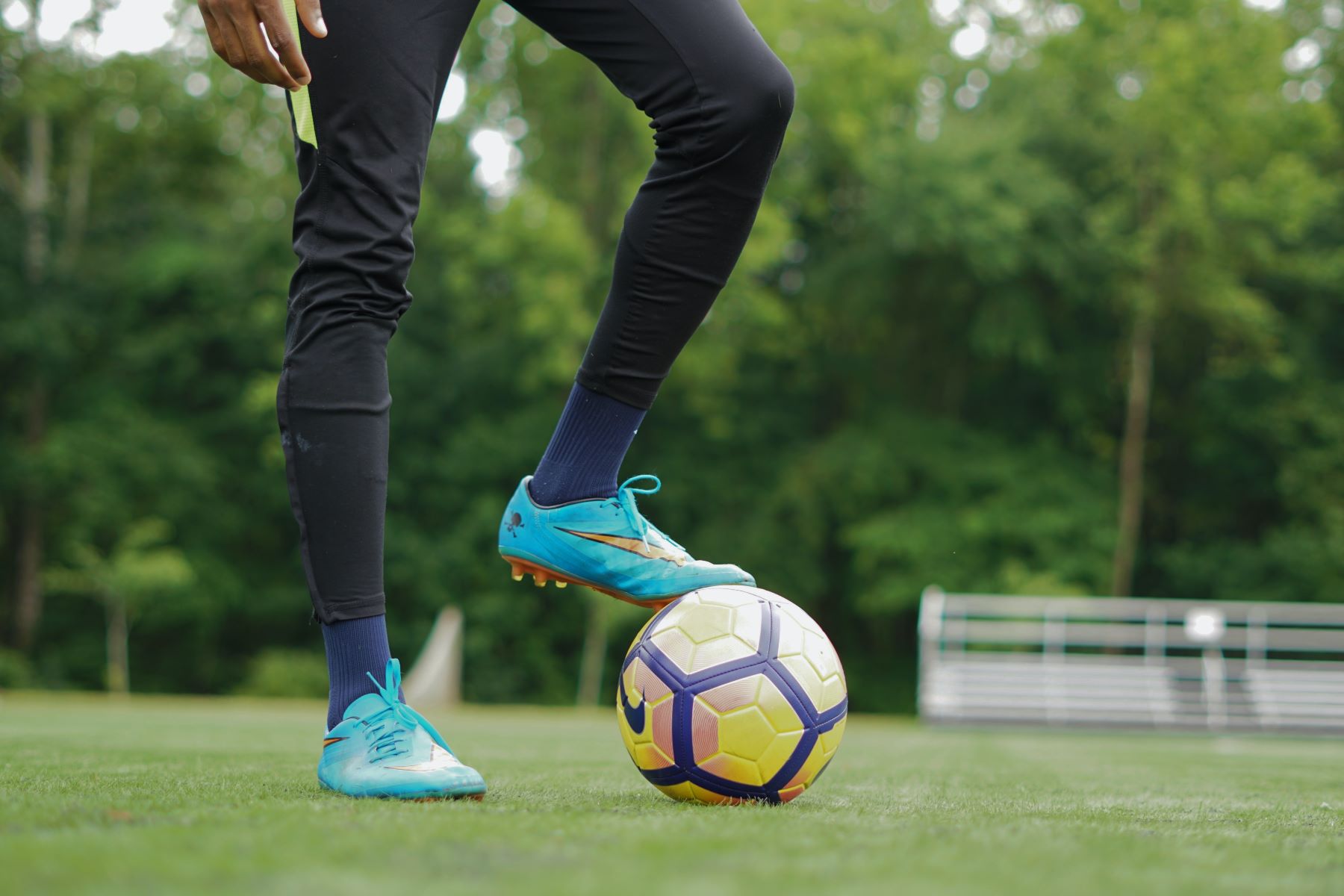Home>Self-Improvement>How To Get Better At Soccer


Self-Improvement
How To Get Better At Soccer
Published: February 26, 2024
Improve your soccer skills with these self-improvement tips and techniques. Enhance your game and reach your full potential on the field.
(Many of the links in this article redirect to a specific reviewed product. Your purchase of these products through affiliate links helps to generate commission for Regretless.com, at no extra cost. Learn more)
Table of Contents
Introduction
Soccer, also known as football in many parts of the world, is a sport that captivates millions of players and fans globally. It's a beautiful game that demands skill, strategy, and teamwork. Whether you're a beginner looking to improve your game or a seasoned player aiming to reach new heights, there are always opportunities to enhance your skills and performance on the field.
In this comprehensive guide, we will explore various aspects of soccer improvement, from mastering the basics to refining advanced techniques. By delving into the nuances of ball control, passing, shooting, agility, speed, endurance, defensive maneuvers, offensive strategies, and mental preparedness, you will gain valuable insights into the multifaceted nature of the game.
Soccer is not just a physical endeavor; it's a mental and emotional one as well. It requires focus, determination, and a deep understanding of the game's intricacies. Whether you're dribbling past opponents, executing a precise pass, or making a crucial defensive play, every moment on the field presents an opportunity for growth and refinement.
As we embark on this journey to elevate your soccer skills, it's essential to approach the process with an open mind and a willingness to learn. Improvement in soccer, as in any pursuit, is a continuous journey marked by dedication, practice, and a passion for the game. By embracing the fundamentals and honing your abilities, you can unlock your full potential as a soccer player and experience the joy of mastering this beautiful sport.
So, lace up your cleats, prepare your mind, and get ready to elevate your game. Whether you're striving for personal improvement, aiming to excel in competitive matches, or simply seeking to enjoy the game at a higher level, the insights and techniques shared in this guide will serve as valuable tools on your path to becoming a better soccer player.
Understanding the Basics
Mastering soccer begins with a solid grasp of the fundamental principles that underpin the game. From understanding the field layout to familiarizing oneself with the rules and positions, a strong foundation in the basics forms the cornerstone of soccer proficiency.
Field and Positions
The soccer field, typically a rectangular expanse of grass, serves as the battleground where players showcase their skills and teamwork. Understanding the dimensions of the field, including the penalty area, center circle, and goal areas, is crucial for strategic positioning and spatial awareness during gameplay. Additionally, grasping the roles and responsibilities associated with different positions, such as defenders, midfielders, and forwards, lays the groundwork for effective teamwork and coordination on the field.
Rules and Regulations
A comprehensive understanding of the rules and regulations governing soccer is essential for players at all levels. From offside rulings to foul recognition, adherence to the game's regulations ensures fair play and sportsmanship. Familiarizing oneself with the intricacies of free kicks, throw-ins, and penalty shootouts empowers players to make informed decisions and contribute meaningfully to their team's performance.
Ball Handling and Dribbling
At the core of soccer proficiency lies the ability to control and maneuver the ball with precision. Mastering basic ball-handling techniques, such as trapping, dribbling, and passing, forms the bedrock of a player's skill set. Developing a deft touch and honing dribbling prowess enables players to navigate the field with confidence, evading opponents and creating scoring opportunities.
Read more: How To Get PR Packages
Teamwork and Communication
Soccer is a team sport that thrives on collaboration and communication. Understanding the importance of cohesive teamwork, effective passing, and strategic positioning fosters a harmonious on-field dynamic. Clear and concise communication among teammates, whether through verbal cues or nonverbal signals, enhances coordination and elevates the overall performance of the team.
Physical and Mental Preparedness
Beyond technical skills, grasping the basics of soccer entails physical and mental readiness. Building endurance, agility, and speed through targeted training regimens lays the groundwork for sustained performance on the field. Moreover, cultivating a resilient mindset, embracing sportsmanship, and exhibiting determination are integral aspects of the game's fundamentals.
By immersing oneself in the foundational aspects of soccer, aspiring players can lay a robust groundwork for their journey toward mastery. Understanding the basics not only instills confidence and proficiency but also fosters a deep appreciation for the intricacies of the beautiful game.
Improving Ball Control
Mastering ball control is a fundamental skill that distinguishes exceptional soccer players. The ability to manipulate the ball with precision, finesse, and confidence is a hallmark of top-tier athletes on the field. Improving ball control involves a multifaceted approach that encompasses technical proficiency, spatial awareness, and strategic decision-making.
Technical Drills and Exercises
Enhancing ball control begins with dedicated practice and targeted drills. Players can focus on honing their first touch, a pivotal skill that involves controlling the ball upon receiving it. By engaging in repetitive drills that involve receiving passes and swiftly maneuvering the ball with precision, players can refine their touch and develop a seamless connection with the ball.
Dribbling exercises, which involve navigating through obstacles and evading defenders while maintaining close ball control, are instrumental in elevating a player's mastery of the ball. These drills not only enhance footwork and agility but also instill confidence in tight spaces, enabling players to retain possession and create scoring opportunities.
Read more: How To Get Honey In Minecraft
Coordination and Balance
Improving ball control is intricately linked to coordination and balance. Players can engage in exercises that focus on enhancing their coordination, such as juggling the ball with different parts of the body. This not only cultivates dexterity and touch but also fosters a deeper kinesthetic understanding of the ball's movement and trajectory.
Furthermore, balance drills, which involve maintaining equilibrium while maneuvering the ball through varying movements, contribute to a player's stability and poise on the field. By refining their balance and coordination, players can execute precise movements and control the ball adeptly in dynamic game situations.
Vision and Spatial Awareness
Effective ball control extends beyond technical prowess; it encompasses a keen sense of spatial awareness and vision. Players can improve their ball control by developing a comprehensive understanding of the field and anticipating the movement of teammates and opponents. This heightened awareness enables players to make split-second decisions, exploit open spaces, and execute strategic passes with precision.
Mental Focus and Repetition
Ultimately, improving ball control demands mental focus and unwavering dedication to repetition. By approaching each practice session with a deliberate focus on refining ball control techniques, players can gradually elevate their proficiency and comfort with the ball. Consistent repetition of drills and exercises fosters muscle memory, enabling players to instinctively react to ball movements and maintain control in high-pressure game scenarios.
In essence, improving ball control is a continuous journey that demands commitment, perseverance, and a holistic approach to skill development. By integrating technical drills, coordination exercises, spatial awareness training, and unwavering mental focus, players can elevate their ball control to new heights, thereby enhancing their overall impact on the field.
Enhancing Passing and Shooting Skills
Elevating passing and shooting skills in soccer is pivotal for players aiming to make a significant impact on the field. The ability to deliver precise passes and execute powerful, accurate shots not only contributes to offensive prowess but also facilitates seamless teamwork and goal-scoring opportunities. Enhancing passing and shooting skills involves a comprehensive approach that encompasses technical refinement, strategic decision-making, and consistent practice.
Read more: How To Get A Title For A Motorcycle
Precision Passing Techniques
Improving passing skills begins with mastering various passing techniques, including the ground pass, lofted pass, and through pass. Ground passes, executed along the ground with precision and pace, are fundamental for maintaining possession and initiating offensive plays. Lofted passes, which involve lifting the ball over opponents to reach teammates, are instrumental for bypassing defensive lines and creating scoring opportunities. Through passes, threaded into open spaces to meet the runs of teammates, are essential for unlocking defenses and setting up goal-scoring chances.
Players can enhance their passing proficiency through targeted drills that emphasize accuracy, timing, and vision. Engaging in passing exercises that simulate game scenarios, such as quick combination plays and long-range distribution, hones a player's ability to deliver incisive passes under varying conditions. Moreover, cultivating a deep understanding of teammates' movements and positioning enables players to anticipate passing opportunities and execute precise deliveries with consistency.
Shooting Accuracy and Power
Shooting skills form the crux of a player's offensive arsenal, dictating their ability to convert scoring opportunities into goals. Enhancing shooting proficiency involves refining techniques such as the instep drive, curling shot, and volleys. The instep drive, characterized by a powerful, straight strike with the laces of the foot, is instrumental for delivering accurate, high-velocity shots on goal. Curling shots, which involve imparting spin on the ball to bend it around defenders and goalkeepers, add an element of unpredictability to a player's shooting repertoire. Additionally, mastering volleys, which entail striking the ball in mid-air, enables players to capitalize on aerial crosses and half-chances in the attacking third.
Consistent shooting practice, encompassing both static and dynamic shooting drills, is essential for refining shooting accuracy and power. Players can focus on striking the ball with precision from varying distances and angles, simulating game-like scenarios to cultivate composure and decisiveness in front of goal. Furthermore, honing the ability to generate power and swerve in shots through targeted exercises contributes to a player's capacity to challenge goalkeepers and find the back of the net with consistency.
Integration and Game Realization
Enhancing passing and shooting skills culminates in the seamless integration of these abilities within the context of gameplay. Players can elevate their passing and shooting proficiency by actively seeking opportunities to apply these skills during training sessions and competitive matches. Embracing a proactive mindset that prioritizes intelligent decision-making and calculated risk-taking empowers players to unleash their passing and shooting prowess in dynamic game situations.
Moreover, fostering a deep understanding of offensive strategies, movement patterns, and positional awareness enables players to recognize optimal passing and shooting opportunities. By leveraging cohesive teamwork and strategic positioning, players can maximize the impact of their passing and shooting skills, contributing to the team's offensive fluidity and goal-scoring efficacy.
In essence, enhancing passing and shooting skills demands a holistic approach that encompasses technical refinement, consistent practice, and game-realization. By honing precision passing techniques, refining shooting accuracy and power, and seamlessly integrating these skills into gameplay, players can elevate their offensive capabilities and make meaningful contributions to their team's success on the field.
Developing Agility and Speed
Developing agility and speed is a cornerstone of soccer performance, empowering players to navigate the field with swiftness, precision, and dynamic movement. The fusion of agility, characterized by rapid changes in direction and nimble footwork, and speed, denoting explosive acceleration and sustained velocity, forms the bedrock of a player's physical prowess on the soccer pitch.
Read more: How To Get Rid Of Perm
Agility Training
Agility training encompasses a diverse array of exercises and drills designed to enhance a player's ability to swiftly change direction, evade opponents, and maintain balance and control during dynamic movements. Cone drills, featuring intricate patterns and rapid directional changes, are instrumental in cultivating agility and footwork proficiency. By weaving through a series of cones with precision and speed, players develop the dexterity and spatial awareness necessary to navigate congested areas of the field and outmaneuver defenders.
Furthermore, ladder drills, which involve intricate footwork patterns through agility ladders, bolster a player's quickness, coordination, and reactive capabilities. These drills not only enhance foot speed and agility but also foster a heightened kinesthetic understanding, enabling players to execute intricate movements with finesse and efficiency.
Speed Enhancement
Speed enhancement in soccer encompasses both linear speed, denoting straight-line acceleration and velocity, and multidirectional speed, which encompasses rapid changes in direction and agility. Players can improve linear speed through sprint drills, focusing on explosive starts, sustained acceleration, and top-end speed. By engaging in sprint intervals and resistance training, players can elevate their sprinting prowess, enabling them to outpace opponents and capitalize on goal-scoring opportunities.
Moreover, multidirectional speed can be honed through shuttle runs, lateral movement drills, and reactive agility exercises. These drills emphasize rapid changes in direction, reactive footwork, and quick acceleration, mirroring the dynamic demands of soccer gameplay. By refining multidirectional speed, players can seamlessly navigate the field, track opponents, and execute swift, decisive movements in response to game dynamics.
Integrated Training Approach
Developing agility and speed necessitates an integrated training approach that encompasses strength conditioning, plyometrics, and proprioceptive exercises. Strength conditioning, focusing on lower body strength and explosive power, forms the foundation for speed and agility development. Plyometric exercises, such as box jumps and bounding drills, enhance a player's explosive force production and reactive capabilities, contributing to rapid acceleration and dynamic movement patterns.
Furthermore, proprioceptive training, which emphasizes balance, stability, and body awareness, complements agility and speed development by fortifying a player's ability to maintain equilibrium during rapid directional changes and high-speed movements. By integrating these diverse training modalities, players can cultivate a comprehensive physical skill set that underpins their agility and speed on the soccer field.
In essence, developing agility and speed in soccer is a multifaceted endeavor that demands a holistic training approach, unwavering dedication, and a commitment to refining physical capabilities. By engaging in targeted agility drills, speed enhancement exercises, and integrated training regimens, players can elevate their on-field performance, outmaneuver opponents, and make impactful contributions to their team's success.
Building Endurance and Stamina
Building endurance and stamina is a vital aspect of soccer performance, enabling players to sustain high-intensity efforts throughout the duration of a match. The dynamic nature of the sport, characterized by continuous movement, sprinting, and rapid transitions between offensive and defensive actions, underscores the significance of robust endurance and stamina levels.
Read more: How To Get Sponges In Minecraft
Aerobic Conditioning
Aerobic conditioning forms the cornerstone of endurance development in soccer. Players engage in sustained, moderate-intensity activities such as long-distance running, interval training, and aerobic exercises to enhance cardiovascular fitness. These training modalities not only bolster the heart and lung capacity but also optimize oxygen utilization, enabling players to efficiently meet the metabolic demands of prolonged physical exertion on the field.
High-Intensity Intervals
Incorporating high-intensity interval training (HIIT) into endurance regimens is instrumental for simulating the intermittent bursts of intense effort characteristic of soccer gameplay. HIIT involves alternating between short, high-intensity bursts of activity and brief recovery periods, mirroring the dynamic energy demands of the sport. By engaging in HIIT protocols, players can elevate their anaerobic threshold, enhance their ability to recover quickly between sprints, and fortify their overall endurance capacity.
Game Realization and Simulated Scenarios
Building endurance and stamina extends beyond traditional conditioning exercises; it encompasses game-realization training and simulated match scenarios. Players can replicate the physical demands of actual gameplay by engaging in drills and small-sided games that emphasize continuous movement, strategic positioning, and dynamic transitions between offensive and defensive actions. By integrating endurance-focused elements into training sessions, players acclimate to the rigors of match play, fortifying their stamina and resilience in game-like conditions.
Recovery and Regeneration
Optimizing recovery and regeneration strategies is integral to endurance development, as it ensures that players can sustain high-performance levels over the course of a match and throughout the season. Adequate rest, hydration, and nutrition play pivotal roles in supporting the body's adaptation to endurance training. Additionally, incorporating recovery modalities such as active rest, foam rolling, and mobility exercises fosters muscular recuperation and mitigates the risk of fatigue-related injuries, enabling players to maintain peak endurance and stamina levels.
Read more: How To Get Soul Guitar
Mental Resilience and Endurance
Endurance and stamina in soccer are not solely physical attributes; they encompass mental resilience and fortitude. Players cultivate mental endurance by embracing a resilient mindset, exhibiting determination in the face of physical fatigue, and maintaining focus and composure during challenging game situations. Mental toughness and endurance enable players to sustain their performance levels, make sound decisions under duress, and exhibit unwavering commitment to the team's objectives throughout the rigors of a match.
In essence, building endurance and stamina in soccer demands a comprehensive approach that integrates aerobic conditioning, high-intensity intervals, game-realization training, recovery strategies, and mental resilience. By fortifying their physical and mental endurance, players can elevate their on-field performance, outlast opponents, and make enduring contributions to their team's success.
Mastering Defensive Techniques
Mastering defensive techniques in soccer is pivotal for players aiming to fortify their team's resilience and thwart opposing attacks effectively. A robust defensive skill set encompasses a blend of tactical acumen, positional awareness, physical prowess, and mental astuteness, all of which converge to form an impenetrable defensive unit on the field.
Tactical Positioning and Anticipation
At the core of defensive mastery lies tactical positioning and anticipation. Players must cultivate a deep understanding of defensive formations, marking strategies, and offside traps to neutralize opponents' offensive maneuvers. By maintaining compact defensive lines, tracking the movements of opposing attackers, and anticipating potential threats, defenders can preemptively intercept passes, block shots, and disrupt the flow of the opposition's attacks.
One-on-One Defending and Tackling
Mastering one-on-one defending and tackling is essential for defenders to nullify individual offensive threats. Players must hone their ability to engage in controlled, decisive duels with opposing attackers, employing precise footwork, body positioning, and timing to dispossess the ball effectively. Tackling techniques, including slide tackles, standing tackles, and interception maneuvers, form the arsenal of a proficient defender, enabling them to thwart advancing opponents and regain possession with authority.
Read more: How To Get Vaseline Out Of Clothes
Aerial Dominance and Clearances
Aerial dominance and clearances are integral facets of defensive mastery, particularly in handling crosses, set pieces, and aerial duels. Defenders must exhibit commanding aerial prowess, utilizing precise timing and vertical leap to intercept lofted passes and deliver decisive clearances. By effectively neutralizing aerial threats and orchestrating strategic clearances, defenders bolster their team's defensive solidity and alleviate pressure in critical moments.
Communication and Coordination
Defensive mastery extends beyond individual prowess; it encompasses cohesive teamwork, communication, and coordinated defensive efforts. Defenders must maintain clear, proactive communication with teammates, orchestrating defensive shifts, marking assignments, and offside traps to fortify the team's defensive structure. Seamless coordination among defenders fosters a unified, impenetrable defensive front, thwarting opposing attacks with collective resolve and strategic acumen.
Recovery and Transition Defense
Mastering defensive techniques entails a proactive approach to recovery and transition defense. Defenders must exhibit rapid recovery speed, swiftly regaining defensive positions and tracking back to nullify counterattacks. By seamlessly transitioning from offensive to defensive roles, defenders mitigate the risk of opposition breakthroughs, fortifying the team's resilience and thwarting potential scoring opportunities with unwavering determination.
In essence, mastering defensive techniques in soccer demands a multifaceted skill set encompassing tactical acumen, one-on-one defending prowess, aerial dominance, communication, and proactive recovery. By honing these defensive attributes, players can elevate their team's defensive fortitude, neutralize opposing threats, and contribute significantly to their team's success on the field.
Perfecting Offensive Strategies
Perfecting offensive strategies in soccer is a multifaceted endeavor that transcends individual skill and encompasses cohesive teamwork, strategic positioning, and dynamic attacking maneuvers. A potent offensive approach not only aims to create scoring opportunities but also fosters fluidity, creativity, and relentless pressure on the opposition's defense. By integrating tactical acumen, intelligent movement, and precise execution, players can elevate their team's offensive efficacy and unlock the full potential of their attacking prowess.
Read more: How To Get Rid Of Evil Eye
Tactical Versatility and Flexibility
Perfecting offensive strategies necessitates tactical versatility and adaptability. Players and coaches must cultivate a deep understanding of diverse offensive formations, movement patterns, and positional interchanges to confound opposing defenses and exploit vulnerabilities. By embracing tactical flexibility, teams can seamlessly transition between attacking schemes, adjust to evolving game dynamics, and capitalize on strategic advantages to penetrate the opposition's defensive lines.
Creative Movement and Interplay
A hallmark of potent offensive strategies lies in creative movement and interplay among attacking players. Dynamic off-the-ball runs, intricate passing sequences, and intelligent positional rotations create disarray in the opposition's defensive structure, opening up space and generating scoring opportunities. Players must exhibit astute spatial awareness, anticipate teammates' movements, and orchestrate cohesive attacking interplay to unlock defensive lines and create goal-scoring chances with precision and finesse.
Strategic Pressing and High-Press Offense
Perfecting offensive strategies involves strategic pressing and a high-press offensive approach to disrupt the opposition's build-up play and regain possession in advanced areas of the field. By implementing coordinated pressing triggers, aggressive ball recovery tactics, and relentless pressure on opposing defenders, teams can force turnovers, capitalize on defensive errors, and launch rapid, incisive attacks to catch the opposition off guard.
Set-Piece Proficiency and Variability
Set-piece proficiency and variability are integral components of perfected offensive strategies. Teams must meticulously craft diverse set-piece routines, including corner kicks, free kicks, and throw-ins, to capitalize on dead-ball situations and create goal-scoring opportunities. By integrating innovative set-piece plays, decoy runs, and unpredictable delivery patterns, teams can unsettle opposing defenses and convert set-piece scenarios into decisive moments that tilt the balance in their favor.
Read more: How To Get Newborn To Sleep In Bassinet
Clinical Finishing and Decision-Making
At the heart of perfected offensive strategies lies clinical finishing and decisive decision-making in the attacking third. Players must exhibit composure, precision, and astute decision-making when presented with goal-scoring opportunities. By honing their ability to execute accurate shots, deliver incisive final passes, and exhibit poise in front of goal, players elevate their team's offensive efficacy and convert promising attacking sequences into tangible results on the scoreboard.
In essence, perfecting offensive strategies in soccer demands a comprehensive blend of tactical acumen, creative interplay, strategic pressing, set-piece proficiency, and clinical finishing. By embracing these offensive tenets, teams can unleash a potent, multifaceted attacking arsenal that not only creates scoring opportunities but also fosters a relentless, dynamic offensive presence on the field.
Mental Preparation and Focus
Mental preparation and focus are integral facets of soccer performance, wielding a profound influence on a player's ability to excel under pressure, exhibit resilience in the face of adversity, and maintain unwavering concentration throughout the rigors of a match. The mental aspect of the game transcends physical skill and tactical acumen, encompassing psychological fortitude, emotional composure, and a resilient mindset that underpins a player's capacity to thrive in competitive environments.
At the core of mental preparation lies the cultivation of a resilient, focused mindset that enables players to navigate the ebbs and flows of a match with unwavering determination. Embracing a positive, proactive mental outlook empowers players to approach challenges as opportunities for growth, exhibiting adaptability, and fortitude in the face of setbacks. By fostering a resilient mindset, players can maintain composure, make sound decisions, and exhibit unwavering commitment to the team's objectives, regardless of the game's dynamics.
Furthermore, mental preparation encompasses visualization and mental rehearsal, enabling players to mentally simulate game scenarios, anticipate challenges, and strategize their responses. By engaging in visualization exercises, players can enhance their spatial awareness, decision-making, and situational preparedness, fostering a deeper understanding of the game's nuances and fortifying their mental acuity on the field.
Maintaining focus throughout the duration of a match is paramount for players aiming to maximize their impact on the field. Unwavering concentration, characterized by a keen awareness of the game's dynamics, opponents' movements, and strategic opportunities, enables players to make split-second decisions, execute precise movements, and capitalize on scoring chances with unwavering precision. By honing their ability to maintain focus, players can elevate their on-field performance, exhibit heightened situational awareness, and make impactful contributions to their team's success.
In essence, mental preparation and focus in soccer demand a holistic approach that integrates psychological fortitude, visualization, and unwavering concentration. By cultivating a resilient, focused mindset, embracing visualization techniques, and maintaining unwavering concentration, players can elevate their mental preparedness, exhibit resilience under pressure, and make enduring contributions to their team's success on the field.
Conclusion
In conclusion, the journey to becoming a better soccer player encompasses a multifaceted approach that transcends mere technical skill and physical prowess. It is a fusion of dedication, perseverance, and a deep understanding of the game's intricacies. From mastering the basics to refining advanced techniques, every facet of a player's development contributes to their overall growth and proficiency on the field.
By delving into the nuances of ball control, passing, shooting, agility, speed, endurance, defensive maneuvers, offensive strategies, and mental preparedness, players embark on a transformative journey toward soccer mastery. The integration of tactical acumen, creative interplay, and unwavering mental focus culminates in a holistic skill set that empowers players to thrive in competitive environments and make enduring contributions to their team's success.
Furthermore, the significance of mental fortitude and resilience cannot be overstated. Soccer is not merely a physical endeavor; it is a mental and emotional one as well. Cultivating a resilient mindset, embracing visualization techniques, and maintaining unwavering concentration are pivotal for players aiming to excel under pressure and exhibit unwavering commitment to their team's objectives.
As players lace up their cleats and step onto the field, they embark on a journey marked by continuous growth, unwavering determination, and a passion for the beautiful game. Whether striving for personal improvement, aiming to excel in competitive matches, or simply seeking to enjoy the game at a higher level, the insights and techniques shared in this guide serve as valuable tools on the path to becoming a better soccer player.
In essence, the pursuit of soccer mastery is a testament to the enduring spirit of dedication, the pursuit of excellence, and the joy of embracing the beautiful game. As players continue to hone their skills, embrace the fundamentals, and elevate their mental and physical acumen, they unlock their full potential as soccer players, contributing to the rich tapestry of the sport and experiencing the sheer exhilaration of mastering this beautiful game.






